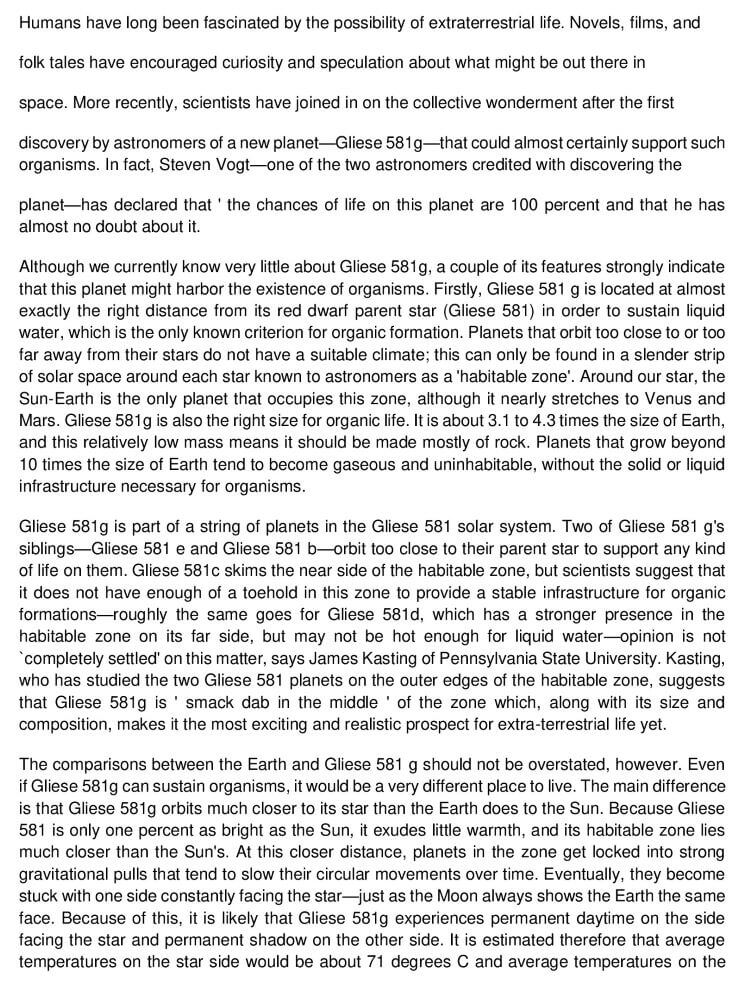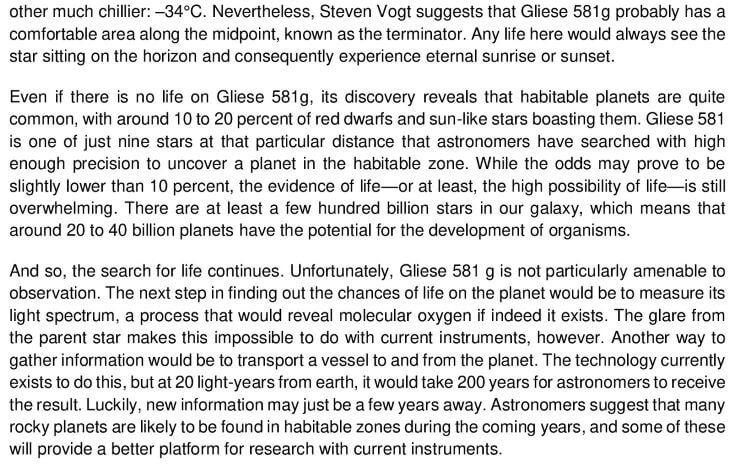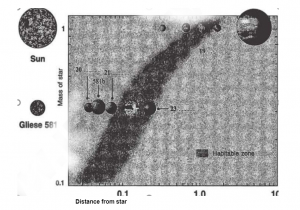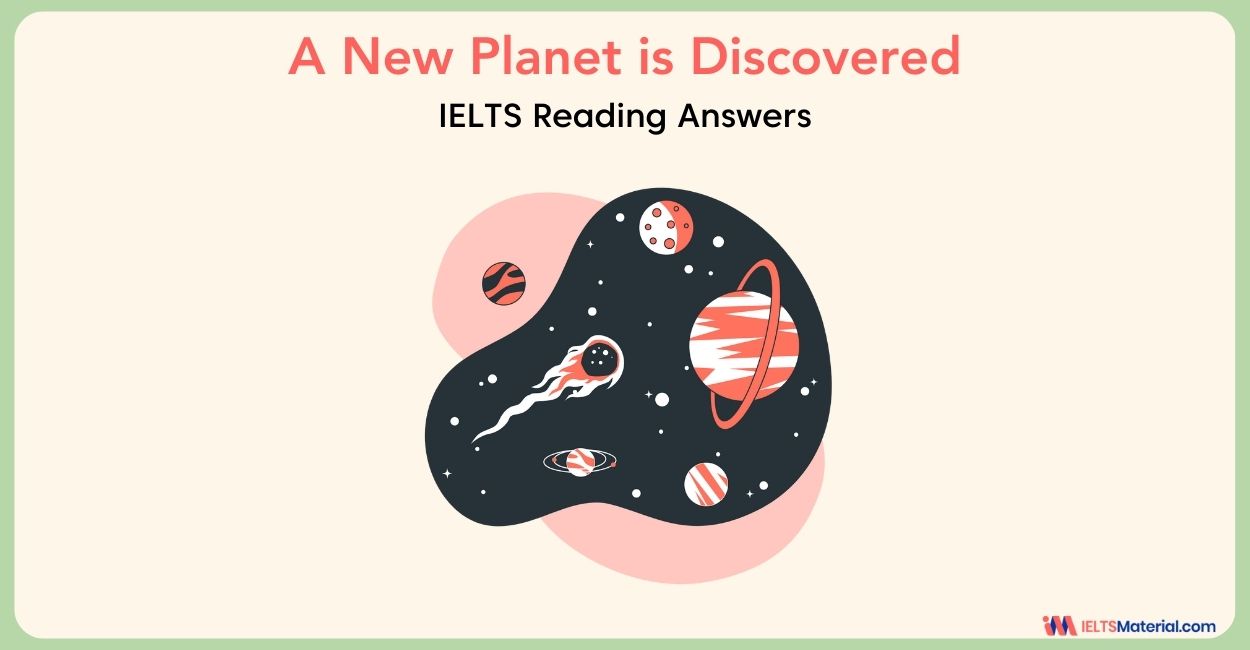A New Planet is Discovered- IELTS Reading Answer
10 min read
Updated On
-
Copy link
Table of Contents

Limited-Time Offer : Access a FREE 10-Day IELTS Study Plan!
The Academic Reading module of the IELTS can be the top-scoring category with diligent practice of passages like ‘A New Planet is Discovered’ and other IELTS Reading recent actual tests. To achieve the best results in this section, you must understand how to approach and answer the different question types in IELTS Academic Reading.
There are 13 questions in the passage, A New Planet is Discovered. The question types found are:
- Matching Information IELTS Reading (Q. 14-18)
- Diagram Completion IELTS Reading (Q. 19-23)
- Short Answer Questions IELTS Reading
Reading Passage
A New Planet is Discovered


Questions 14-18
Reading Passage 2 has five paragraphs, A—E.
Which paragraph contains the following information?
Write the correct letter, A—E, in boxes 14-18 on your answer sheet.
14 A reason why we cannot learn much more about Gliese 581g in the near future
15 An estimate of the number of planets in habitable zones
16 An explanation for why Gliese 581g may not rotate
17 Gliese 581 g’s location in relation to other planets
18 A prerequisite for the beginning of life
Questions 19-23
Complete the diagram below.
Choose the correct letter A—E from the box below.
Write your answers in boxes 19-23 on your answer sheet.
Distance from star

| A Gliese 581c
B Gliese 581d C Gliese 581e D Gliese 581g E Earth |
Questions 24-26
Answer the questions below using NO MORE THAN TWO WORDS from the passage for each answer.
Write your answers in boxes 24-26 on your answer sheet.
24 To what can Gliese 581g be compared because of its lack of circular motion?
25 What is the name for the central meridian on Gliese 581g where there is no darkness?
26 What do astronomers now realize are not rare occurrences?
Answers of A New Planet is Discovered Reading Answers With Location and Explanations
Go through the answers and detailed explanations of each question in the ‘A New Planet is Discovered’ passage and prepare to get a high IELTS Reading band score.
14 Answer: E
Question type: Matching information
Answer location: Paragraph E, lines 1-7
Answer explanation: “And so, the search for life continues. Unfortunately, Gliese 581 g is not particularly amenable to observation. The next step in finding out the chances of life on the planet would be to measure its light spectrum, a process that would reveal molecular oxygen if indeed it exists. The glare from the parent star makes this impossible to do with current instruments, however. Another way to gather information would be to transport a vessel to and from the planet. The technology currently exists to do this, but at 20 light-years from earth, it would take 200 years for astronomers to receive the result.” This paragraph clearly states the reason why we, at present, can’t gauge the details of the planets and why in the near future, we can’t derive the results.
15 Answer: D
Question type: Matching information
Answer location: Paragraph D, lines 1-4
Answer explanation: “Even if there is no life on Gliese 581g, its discovery reveals that habitable planets are quite common, with around 10 to 20 percent of red dwarfs and sun-like stars boasting them. Gliese 581 is one of just nine stars at that particular distance which astronomers have searched with high enough precision to uncover a planet in the habitable zone.” This paragraph estimates the number of planets that are habitable.
16 Answer: C
Question type: Matching information
Answer location: Paragraph C, lines 2-6
Answer explanation: “The main difference is that Gliese 581g orbits much closer to its star than the Earth does to the Sun. Because Gliese 581 is only one percent as bright as the Sun, it exudes little warmth, and its habitable zone lies much closer than the Sun’s. At this closer distance, planets in the zone get locked into strong gravitational pulls that tend to slow their circular movements over time.” This clearly explains the reason behind the inability of rotation in Gliese 581g.
17 Answer: B
Question type: Matching information
Answer location: Paragraph B, lines 1-2
Answer explanation: “Two of Gliese 581 g’s siblings—Gliese 581 e and Gliese 581 b—orbit too close to their parent star to support any kind of life on them. Gliese 581c skims the near side of the habitable zone, but scientists suggest that it does not have enough of a toehold in this zone to provide a stable infrastructure for organic formations—roughly the same goes for Gliese 581d, which has a stronger presence in the habitable zone on its far side, but may not be hot enough for liquid water.” This paragraph evidently talks about the position of various planets of Gliese 581 and the location of Gliese 581g in reference to other planets.
18 Answer: A
Question type: Matching information
Answer location: Paragraph A, lines 2-7
Answer explanation: “Firstly, Gliese 581 g is located at almost exactly the right distance from its red dwarf parent star (Gliese 581) in order to sustain liquid water, which is the only known criterion for organic formation. Planets that orbit too close to or too far away from their stars do not have a suitable climate; this can only be found in a slender strip of solar space around each star known to astronomers as a ‘habitable zone’.” This paragraph states the conditions and prerequisites for life on the planets.
19 Answer: E
Question type: Diagram completion
Answer location: Paragraph A, lines 4-7
Answer explanation: “Planets that orbit too close to or too far away from their stars do not have a suitable climate; this can only be found in a slender strip of solar space around each star known to astronomers as a ‘habitable zone’. Around our star—the Sun-Earth is the only planet that occupies this zone..” Hence, the answer should be Earth as the reference of Gliese 581 g is made with Earth, and as per the condition and positioning mentioned in the passage, the answer is Earth.
20 Answer: C
Question type: Diagram completion
Answer location: Paragraph B, lines 1-3
Answer explanation: “Two of Gliese 581 g’s siblings—Gliese 581 e and Gliese 581 b—orbit too close to their parent star to support any kind of life on them. “ Since 581 b is already given in the diagram, the only possibility left is 581 e, hence the answer is 581 e.
21 Answer: A
Question type: Diagram completion
Answer location: Paragraph B, lines 3-5
Answer explanation: “Gliese 581c skims the near side of the habitable zone, but scientists suggest that it does not have enough of a toehold in this zone to provide a stable infrastructure for organic formations” This suggests that the answer is 581 c as the lines suggest that the position of Gliese 581c is nearer to the sun than other planets.
22 Answer: D
Question type: Diagram completion
Answer location: Paragraph B, lines 8-10
Answer explanation: “Kasting, who has studied the two Gliese 581 planets on the outer edges of the habitable zone, suggests that Gliese 581g is ‘ smack dab in the middle ‘ of the zone which, along with its size and composition, makes it the most exciting and realistic prospect for extra-terrestrial life yet.” This suggests that the planet Gliese 581g lies in the middle and is the most conducive planet to support life on it. Hence, the answer as per the position should be Gliese 581g.
23 Answer: B
Question type: Diagram completion
Answer location: Paragraph B, lines 5-6
Answer explanation: “…..—roughly the same goes for Gliese 581d, which has a stronger presence in the habitable zone on its far side,..” This suggests that the planet Gliese 581d lies the farthest from the planet. Therefore, the answer is Gliese 581d.
24 Answer: The moon
Question type: Short-Answer question
Answer location: Paragraph C, lines 7-10
Answer explanation: “Eventually, they become stuck with one side constantly facing the star—just as the Moon always shows the Earth the same face. Because of this, it is likely that Gliese 581g experiences permanent daytime on the side facing the star and permanent shadow on the other side.” Thus, the comparison made is with the moon in relation to the circular motion. Therefore, the answer is the moon.
25 Answer: The Terminator
Question type: Short-Answer question
Answer location: Paragraph C, lines 11-14
Answer explanation: “ Nevertheless, Steven Vogt suggests that Gliese 581g probably has a comfortable area along the midpoint, known as the terminator. Any life here would always see the star sitting on the horizon and consequently experience eternal sunrise or sunset.” These lines clearly state that the area in the midpoint of the Gliese 581 g experiences the most comfortable and favorable conditions for the living organisms and that area is called, “The Terminator”.
26 Answer: Habitable planets
Question type: Short-Answer question
Answer location: Paragraph D, first lines and E- last lines.
Answer explanation: “Even if there is no life on Gliese 581g, its discovery reveals that habitable planets are quite common, with around 10 to 20 percent of red dwarfs and sun-like stars boasting them.” and, “Astronomers suggest that many rocky planets are likely to be found in habitable zones during the coming years, and some of these will provide a better platform for research with current instruments.” This suggests that the astronomers believe that many habitable planets are likely to be found as there is a higher probability of occurrence of such planets than what was believed to be.
Tips to Solve the Question Types in A New Planet is Discovered IELTS Reading Answers
Now that you have the answers and explanations for A New Planet is Discovered Reading Answers, let’s explore some IELTS exam preparation tips for answering the three question types.
Matching Information:
You will be given a list of three to six statements in this type of question, and you will need to match the information in each statement to the corresponding information in a paragraph in the reading passage of IELTS exam.
- Read the instructions followed by the list of statements – You will get an idea of the main idea of each statement. Also, figure out the keywords from each statement.
- Scan and skim through the passage – Use these reading techniques to go through the text and find out which paragraph or section contains the relevant information of the statements.
- One paragraph will contain information given in a statement – While one statement corresponds to one passage, some passages may not have any answer. Remember this to avoid repetition or wasting your time.
- Identify the answer – Once you identify the keywords and find out the corresponding paragraph that contains the information, follow this process for the others.
Diagram Completion:
The way to solve the diagram completion questions of the IELTS Reading is similar to Table Completion. You will be asked to fill in the blanks in a small passage given in the form of a diagram with the relevant words or numbers. So, let us revise the strategies.
- Read the instructions carefully. It will help you determine the word limit (no more than two, one word, etc) and important terms like ‘using words from the text’ or ‘from the text’. You have to follow these strictly.
- Go through the incomplete diagram first. Also, think about keywords and how they could be represented by synonyms or paraphrasing.
- Locate where the information is by scanning quickly. If you can’t, move on.
- Study the reading text by using the skimming and scanning techniques. It will help to establish the answer quickly. When scanning for your answer, make sure you are thinking about paraphrasing and synonyms.
- The answers appear in the same order as the questions. Also, check your spelling and remember that your answer should be grammatically correct.
Short-Answer Type Questions:
Short Answer Type Questions is a type of IELTS reading question that requires you to scan through a passage and answer questions based on the information given following the word limit. To answer short-answer type questions, you can use the following strategies:
- Go through the instructions carefully – You will find the word limit for the answers there, which you have to follow strictly.
- Read the questions and highlight the keywords – The next step will be to read the questions to know what keywords or information you have to look for in the passage.
- Use the ‘Wh’ words in the questions – Words like ‘What’, (names), ‘Where’ (place), ‘When’ (time), etc. will enable you to understand the type of information you are looking for.
- Use reading techniques to study the passage quickly – Do not waste your time reading the whole passage. Scan through the passage to find out the keywords or their synonyms using the IELTS Reading keyword techniques. If headers are given, use them to locate the answer easily.
- Check the spelling – Once you find the answer, note the correct spelling in your answer sheet.
Check More IELTS Reading Answers
Practice IELTS Reading based on question types

Start Preparing for IELTS: Get Your 10-Day Study Plan Today!
Recent Articles

Nehasri Ravishenbagam

Haniya Yashfeen

Haniya Yashfeen

Haniya Yashfeen




Post your Comments